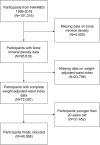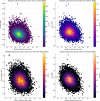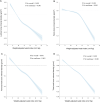Associations between weight-adjusted waist index and bone mineral density: results of a nationwide survey
- PMID: 37537589
- PMCID: PMC10399051
- DOI: 10.1186/s12902-023-01418-y
Associations between weight-adjusted waist index and bone mineral density: results of a nationwide survey
Abstract
Background: The weight-adjusted waist circumference index (WWI) is a novel obesity indicator that offers improved accuracy in assessing both muscle and fat mass compared to traditional measures. This study aimed to investigate the association between WWI and bone mineral density (BMD) in adults.
Methods: Weighted multivariate logistic regression, subgroup analysis, interaction tests and restricted cubic spline (RCS) curves were used to explore the relationship between WWI and BMD based on data from the National Health and Nutrition Examination Survey (NHANES).
Results: This study had 40,568 individuals in total. At all four measurement sites, we detected a negative linear correlation between WWI and BMD. Even when quartile factors for WWI were created, this unfavorable connection maintained. In comparison to those in the lowest quartile, those in the highest percentile of WWI showed declines in lumbar BMD of 0.08 g/cm2 and femoral neck BMD of 0.03 g/cm2, respectively. This adverse correlation, nevertheless, differed among several categories.
Conclusions: Our findings suggest an adverse correlation between WWI and BMD among US adults. Employing WWI as a tool for osteoporosis prevention in the general population may enhance interventions.
Keywords: Bone mineral density; NHANES; Obesity; Osteoporosis; Weight-adjusted-waist.
© 2023. BioMed Central Ltd., part of Springer Nature.
Conflict of interest statement
The author declares that he has no competing interests.
Figures



Similar articles
-
The association between weight-adjusted-waist index and total bone mineral density in adolescents: NHANES 2011-2018.Front Endocrinol (Lausanne). 2023 May 17;14:1191501. doi: 10.3389/fendo.2023.1191501. eCollection 2023. Front Endocrinol (Lausanne). 2023. PMID: 37265707 Free PMC article.
-
Association between weight-adjusted waist index and bone mineral density in adolescents.Sci Rep. 2024 Jul 17;14(1):16509. doi: 10.1038/s41598-024-66565-1. Sci Rep. 2024. PMID: 39019936 Free PMC article.
-
Association of weight-adjusted waist index with hyperuricemia and gout among middle-aged and older adults in America: a cross-sectional analysis of NHANES 2007-2014.Clin Rheumatol. 2024 Aug;43(8):2615-2626. doi: 10.1007/s10067-024-07011-5. Epub 2024 Jun 11. Clin Rheumatol. 2024. PMID: 38861229
-
Relationship Between Weight-Adjusted Waist Index and Osteoporosis in the Senile in the United States from the National Health and Nutrition Examination Survey, 2017-2020.J Clin Densitom. 2023 Apr-Jun;26(2):101361. doi: 10.1016/j.jocd.2023.02.002. Epub 2023 Mar 2. J Clin Densitom. 2023. PMID: 36922294
-
Association between Weight-Adjusted Waist Index and depressive symptoms: A nationally representative cross-sectional study from NHANES 2005 to 2018.J Affect Disord. 2024 Apr 1;350:49-57. doi: 10.1016/j.jad.2024.01.104. Epub 2024 Jan 12. J Affect Disord. 2024. PMID: 38220117 Review.
Cited by
-
Associations between apolipoprotein B and bone mineral density: a population-based study.BMC Musculoskelet Disord. 2023 Nov 2;24(1):861. doi: 10.1186/s12891-023-06990-x. BMC Musculoskelet Disord. 2023. PMID: 37919727 Free PMC article.
-
Weight-Adjusted Waist Index: an anthropometric measure for frailty in older adults.Eur Geriatr Med. 2024 Dec;15(6):1731-1738. doi: 10.1007/s41999-024-01047-1. Epub 2024 Sep 5. Eur Geriatr Med. 2024. PMID: 39237732
-
Non-linear association of sleep duration with osteoarthritis among U.S. middle-aged and older adults.BMC Public Health. 2024 Dec 23;24(1):3565. doi: 10.1186/s12889-024-21140-1. BMC Public Health. 2024. PMID: 39716177 Free PMC article.
-
The association of weight-adjusted waist index with the risk of osteoporosis in patients with type 2 diabetes: a cross-sectional study.J Orthop Surg Res. 2024 Aug 29;19(1):518. doi: 10.1186/s13018-024-04991-7. J Orthop Surg Res. 2024. PMID: 39210413 Free PMC article.
-
Associations between dietary fatty acids intake and abdominal aortic calcification: a national population-based study.Lipids Health Dis. 2024 Mar 9;23(1):73. doi: 10.1186/s12944-024-02059-3. Lipids Health Dis. 2024. PMID: 38461250 Free PMC article.
References
-
- Sambrook P, Cooper C. Osteoporosis. Lancet. 2006;367(9527):2010–8. - PubMed
-
- Black DM, Rosen CJ. Clinical practice. Postmenopausal osteoporosis. N Engl J Med. 2016;374(3):254–62. - PubMed
-
- Lingvay I, Sumithran P, Cohen RV, le Roux CW. Obesity management as a primary treatment goal for type 2 diabetes: time to reframe the conversation. Lancet. 2022;399(10322):394–405. - PubMed
MeSH terms
LinkOut - more resources
Full Text Sources
Medical

